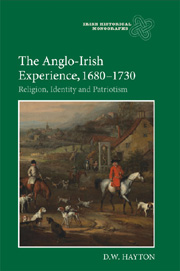Book contents
- Frontmatter
- Contents
- List of Illustrations
- Acknowledgments
- Abbreviations
- Preface
- Note on dates and quotations
- 1 From barbarian to burlesque: the changing stereotype of the Irish
- 2 Anglo-Irish attitudes: shifting perceptions of national identity
- 3 Aristocratic decline: the fall of the house of Ormond
- 4 A presence in the country: the Brodricks and their ‘interest’
- 5 ‘Commonwealthman’, unionist and king's servant: Henry Maxwell and the Whig imperative
- 6 ‘Paltry underlings of state’? The character and aspirations of the ‘Castle’ party, 1715–32
- 7 Creating industrious Protestants: charity schools and the enterprise of religious and social reformation
- 8 A question of upbringing: Thomas Prior, Sir John Rawdon, 3rd Bt, and the mentality and ideology of ‘improvement’
- Bibliography of secondary works
- Index
4 - A presence in the country: the Brodricks and their ‘interest’
Published online by Cambridge University Press: 05 February 2013
- Frontmatter
- Contents
- List of Illustrations
- Acknowledgments
- Abbreviations
- Preface
- Note on dates and quotations
- 1 From barbarian to burlesque: the changing stereotype of the Irish
- 2 Anglo-Irish attitudes: shifting perceptions of national identity
- 3 Aristocratic decline: the fall of the house of Ormond
- 4 A presence in the country: the Brodricks and their ‘interest’
- 5 ‘Commonwealthman’, unionist and king's servant: Henry Maxwell and the Whig imperative
- 6 ‘Paltry underlings of state’? The character and aspirations of the ‘Castle’ party, 1715–32
- 7 Creating industrious Protestants: charity schools and the enterprise of religious and social reformation
- 8 A question of upbringing: Thomas Prior, Sir John Rawdon, 3rd Bt, and the mentality and ideology of ‘improvement’
- Bibliography of secondary works
- Index
Summary
A few miles to the south of the town of Midleton, in County Cork, near the shore of the Owenacurra estuary, may be found the remains of Ballyannan House, once the principal Irish residence of the Brodricks, in their time the greatest landed family in the district, and one of the most powerful political dynasties in Protestant Ireland. Alan Brodrick (c. 1655–1728) and his elder brother Thomas (1654–1730) emerged after the Williamite revolution as prominent members of the restored Irish parliament, at first alongside their father among the front rank of opposition speakers in the short-lived session of 1692; then, following the ministerial reconstruction undertaken by Lord Deputy Capell in 1694–5, in their own right as ‘undertakers’ for successive Whig governments. Alan was made solicitor-general of Ireland in 1695, and elected to the chair of the Irish House of Commons in 1703. By this time he had become the undisputed chief of the Whig faction in Ireland. Promotion to the judicial bench by the Whig administration in 1709 invited dismissal at the hands of the incoming Tory viceroy, Ormond, in 1711, but he returned to parliament in 1713 as Whig leader and once more as Commons Speaker. After the Hanoverian succession he was the obvious choice to be appointed lord chancellor of Ireland. However, from the woolsack he could no longer dominate his fellow Irish Whigs in quite the same way, and had to contend with the rivalry of the new Speaker, William Conolly.
- Type
- Chapter
- Information
- The Anglo-Irish Experience, 1680-1730Religion, Identity and Patriotism, pp. 77 - 103Publisher: Boydell & BrewerPrint publication year: 2012



